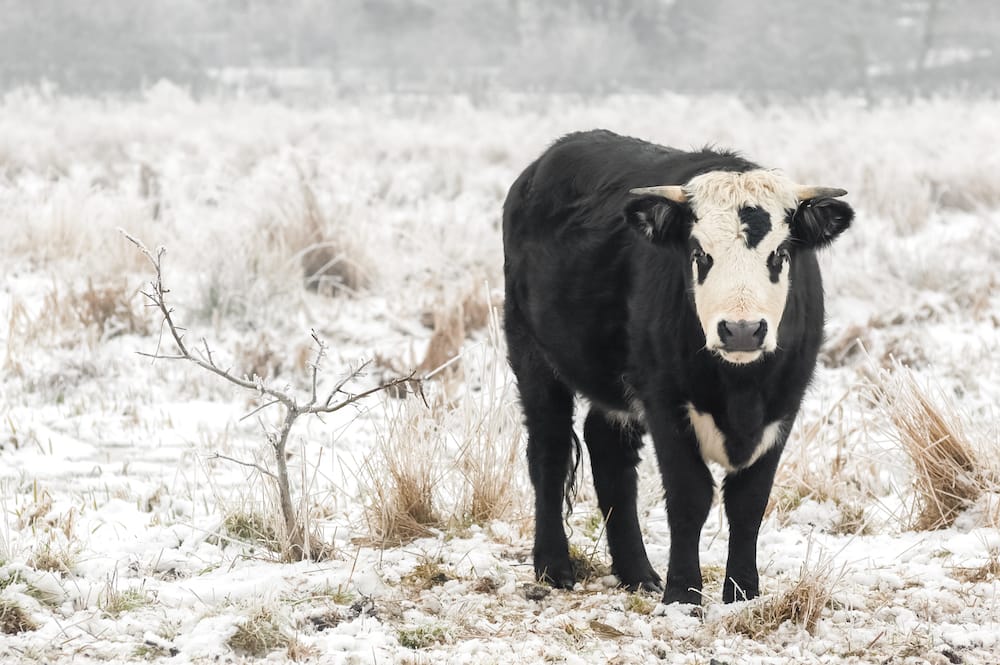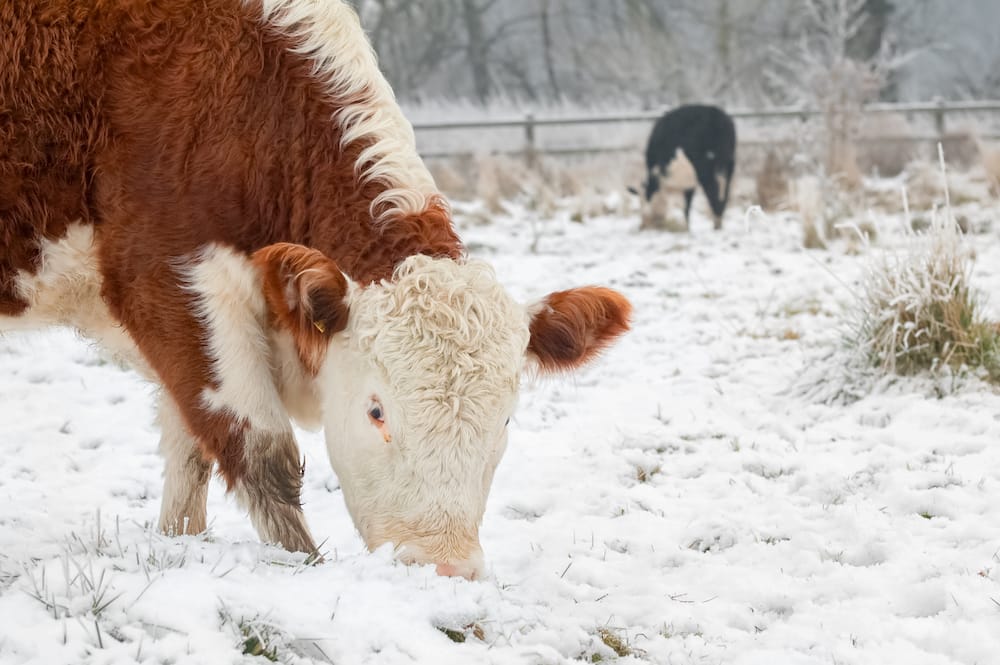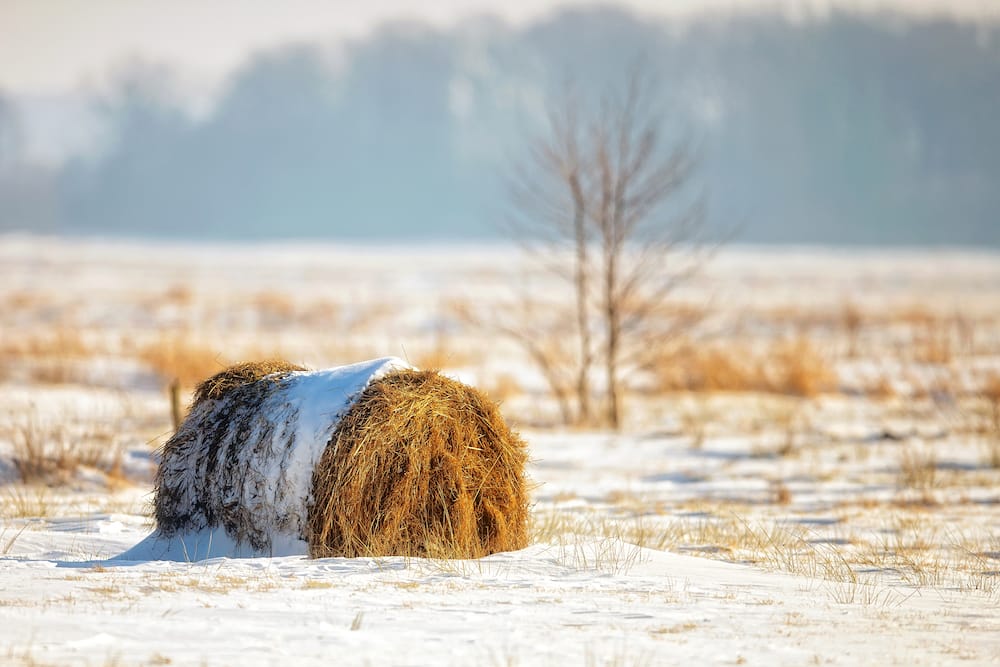We don’t stop going outside just because its winter, do we?
We simply make a few adjustments to our wardrobe, cosy up with a nice warm jacket, gloves and boots, and go on with our lives!
Winter grazing is just like that. It’s all about making a few adjustments so that your cattle can continue to graze during the early onset of winter, instead of staying put and munching on expensive cattle feed rations.
Studies have shown that the average feed costs are quite high. Depending on forage availability and severity of winter, the feed costs can range from $120/ year in South Florida to up to $290/ year in North Dakota.
Even in other countries around the world like Australia, UK and South Africa, the feed cost for cattle is quoted as one of the most expensive operating costs. But, winter grazing can help reduce this.
In this article, we’re going to be talking all about winter grazing strategies, and the core rules and principles of grazing in winter.
Contrary to popular belief, winter grazing could be real simple, if you have a solid winter grazing plan that will help you:
- Make optimal use of your winter pastures
- Improve the quality of your winter pastures
- Train your cattle well so that they begin to love winter and graze well even when its snowy
- Protect your cattle’s health during winter
- Prolong winter grazing as much as you can
- Protect pastures during spring thaw
So first, let us address the main reason as to why we need winter grazing.

In most beef operations (no matter the size), feed represents 50% to 60% of the total costs – which means hay, silage or other feed ration. Pasture is a lot cheaper than all of these.
It’s simple. The more your cattle graze, the lower your production costs will be.
Or, more pasture means more profit!
Apart from the decrease in feed cost, more grazing also means lesser fuel use, wear and tear on equipment and labor.
So, how do we go about putting a successful grazing management strategy in place?
Grazing in winter could actually be much simpler than grazing during the growing season! In summer, you need to manipulate your pastures to prepare the perfect winter crop. But once the growing season finishes, all you have to do it ration out your winter pastures until it gets over and you switch to stored feed or until the next growing season commences.
A good tip here is to plan out the pattern of your winter herd migration so that you can allocate slices of your winter pasture according to your livestock. Since your grass will not grow in winter, you know that you can graze one slice of pasture only once.
A winter grazing map will help you plan how you want your cattle to move through your winter pastures so that you and your cows make full use of the grass that’s available.

Start your winter pasture plan with the shortest pastures first and those that are highly vulnerable to nutrient leaching or getting crushed/covered in snow.
Then, you can save the tallest pastures for the middle of winter when snow is at its deepest.
These are 4 important points that your winter grazing plan should account for:
- Very cold periods
- Muddy seasons
- Heavy snow
- Areas with snow drifts
You also know that winter grazing with a cow/calf herd is possible only if the calving season is scheduled during the growing season, that is, 3 – 4 weeks after the grass has resumed growth and the cows have had enough time to fatten themselves up prior to calving.
Pastures after the growing season:
Grass becomes dormant when the growing season ends.
This allows frost to kill the entire grass plant above the ground without having any impact on the next year’s re-growth. The roots become inactive and thus the root mass is preserved. This root mass is what helps to provide that push of growth when the next growing season becomes.
Since only the roots are what’s more important, the above-ground material, that is the grass, can be grazed off fully without harming the next growing season’s regrowth.
Grazing during winter does a lot of good to grass. Grazing during winter removes all the dead plant material that would otherwise choke out the new grass roots that begin to develop the next spring.
In short, the apt thing to do is to leave a 6-10 inch tall grass stubble during the growing season. Once the growing season ends, change your strategy to really short grazing so that each slice of pasture is completely used before you move on to the next slice.
Daily pasture slices are important for winter grazing:
Daily pasture slices are an important part of intensive grazing management.
Daily pasture slices make sure that your cows get a super healthy meal every single day. When you offer your cattle enough pasture for a single day, it makes them eat fast, and eat the whole plant! The next day, they will get fresh, untouched grass.
On the other hand, when you offer your cattle more than a single pasture slice, they will graze off the top of the pasture only, eating up only the most tasty bits. The next day, they end up having access only to leftovers which are lesser in nutrients than what they ate the previous day.
This also causes the pasture quality to deteriorate.
These daily grazing slices make sure that cattle are able to maintain weight gain in winter and keep their bodies nice and chubby during the winter too, thus keeping themselves warm too!
Portable fences and electric fences are often used to keep your cows/calves restricted to daily slices. Cattle can be easily trained to respect electric fences. Sometimes during winter, the snow on the ground can act as an insulator and prevents electricity from travelling back into the ground.
So be sure to double check that your electric fences are working!

Pasture trampling:
You must have heard of the old saying that cattle feet consume 7 times as much as cattle mouths!
Daily pasture slices mean that the cows don’t have too much space to wander about trampling the pasture. This means that you will lose a lot of pasture to those cow hooves, and you’ll have to switch to more expensive cattle feed sooner.
Also, in winter, you don’t get a second chance to graze your pasture. When the pasture is trampled, since its winter, it won’t grow back up again.
Grass trampled on by cows get crushed right into the soil and are not reclaimable.
Let’s talk about snow:
You must have noticed that in winter, sometimes, snow can turn into hard layers similar to concrete.
This happens when the snow is disturbed.
Disturbed snow causes the snow crystals to re-crystallize and bind together. This happens when the air particles trapped between the snow crystals are removed. This makes the snow hard and it just takes a few hours to harden once it’s disturbed.
When you have daily pasture slices, the cows use up the pasture completely before the snow disturbance occurs and forms a thick, hard layer above the pasture, cutting off access to the cows.
Manure management during winter:
When your cattle have access to several days worth of pasture, they start using their favorite spots for ruminating and sleeping. This ends up removing the valuable nutrients from your pasture and makes it concentrated in a few small spots.
This means that the pastures will need more fertilizer during the next season. The areas where the cattle have chosen as their cosy spots may end up being over-fertilized, trampled or damaged.
Cow diet:
Just like how we go to dieticians who tell us how to eat healthier, you can use a monthly forage sampling program and give that to your livestock nutritionist who can tell you if your cows are getting enough nutrients in winter.
This way, even if your cows have a small deficiency in any nutrient, it can be easily fixed by giving a supplement mix and you can continue to graze your pasture even after the quality slightly begins to deteriorate in winter.
Water in winter:
You’ll need winterized water sites so your cattle have enough drinking water.
If the distance to the water body is too long, the cows will tend to start to eat the snow!
Preparing for the muddy season:
Your winter grazing should be planned in such a way that once the winter ends, your pasture rotation has led the cows back to right near the water troughs. There has to be a short distance to water during spring so that the cows don’t trample your pastures when the frost is coming out of the ground and it turns muddy.
Also, when your cattle are near the water troughs, they drink from there, instead of from the muddy puddles that are filled with bacteria. This protects their health.

Emergency stash of hay:
No matter what, always keep a stash of emergency feed for backup.
This is for cases of a drought, an unpredictable storm or simply if your winter pasture declines in quality.
We hope this article was useful and helps you extend your grazing season into winter so that your cows continue to graze naturally on your pastures. Head to Pasture.io for more information on how we can help you provide valuable data to make your winter grazing strategies a piece of cake!
This brings us to the end of this article. I do hope you enjoyed reading it. Please feel free to leave a comment below and I promise to reply.
Until then, Happy Farming!
- The Dedicated Team of Pasture.io, 2020-09-16